Best Evergreen Trees for Privacy and Year-Round Interest in 2025
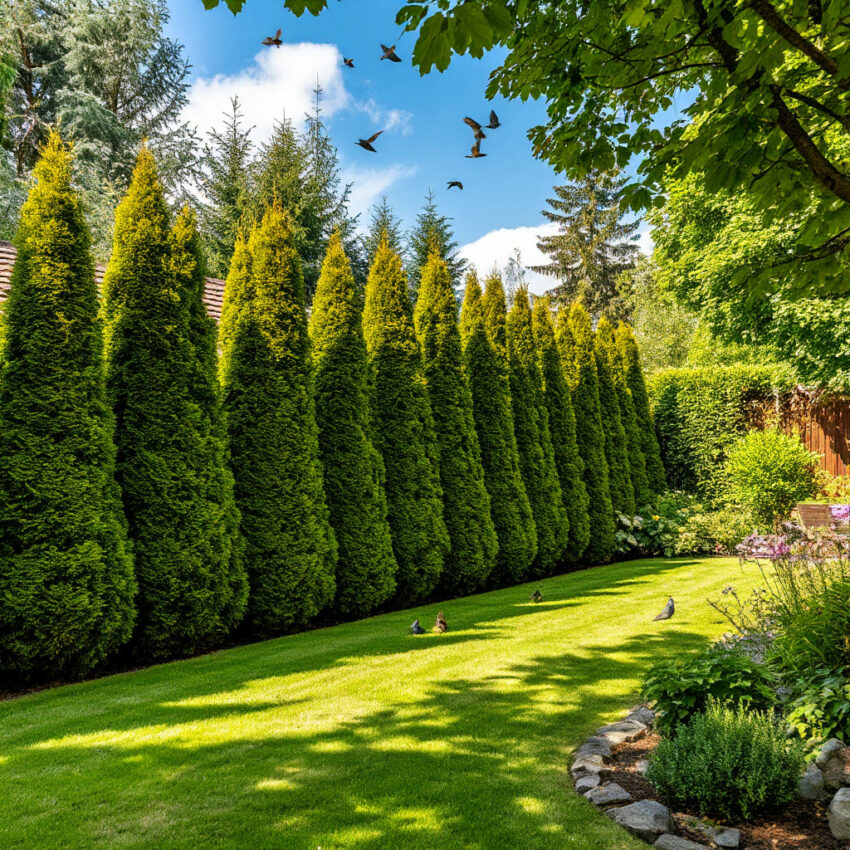
Nosy neighbors, busy streets, and shrinking yard sizes make privacy more valuable than ever. Homeowners want a natural way to create seclusion that still looks attractive year-round. The best evergreen trees for privacy 2025 deliver exactly that: living barriers that stay full and green in every season. This term refers to hardy conifers or broadleaf species that never shed their foliage all at once. They provide dense coverage while keeping a landscape visually appealing. Arborvitae, cypress, and holly are all classic examples that have become staples in American backyards.
These trees do more than block a neighbor’s view. They cut down on street noise, shield from harsh winds, and give birds and pollinators a safe habitat. Experts from the Arbor Day Foundation note that demand for evergreen privacy trees continues to rise as climate patterns shift. More people want outdoor areas that feel private without relying on fences alone. Let’s look at the best options, planting tips, and cost analysis that will matter most in 2025. For your convenience, we provide a step-by-step guide to planting right away. Stick around for a downloadable privacy checklist—species picks, spacing that closes fast, and layouts that actually work.
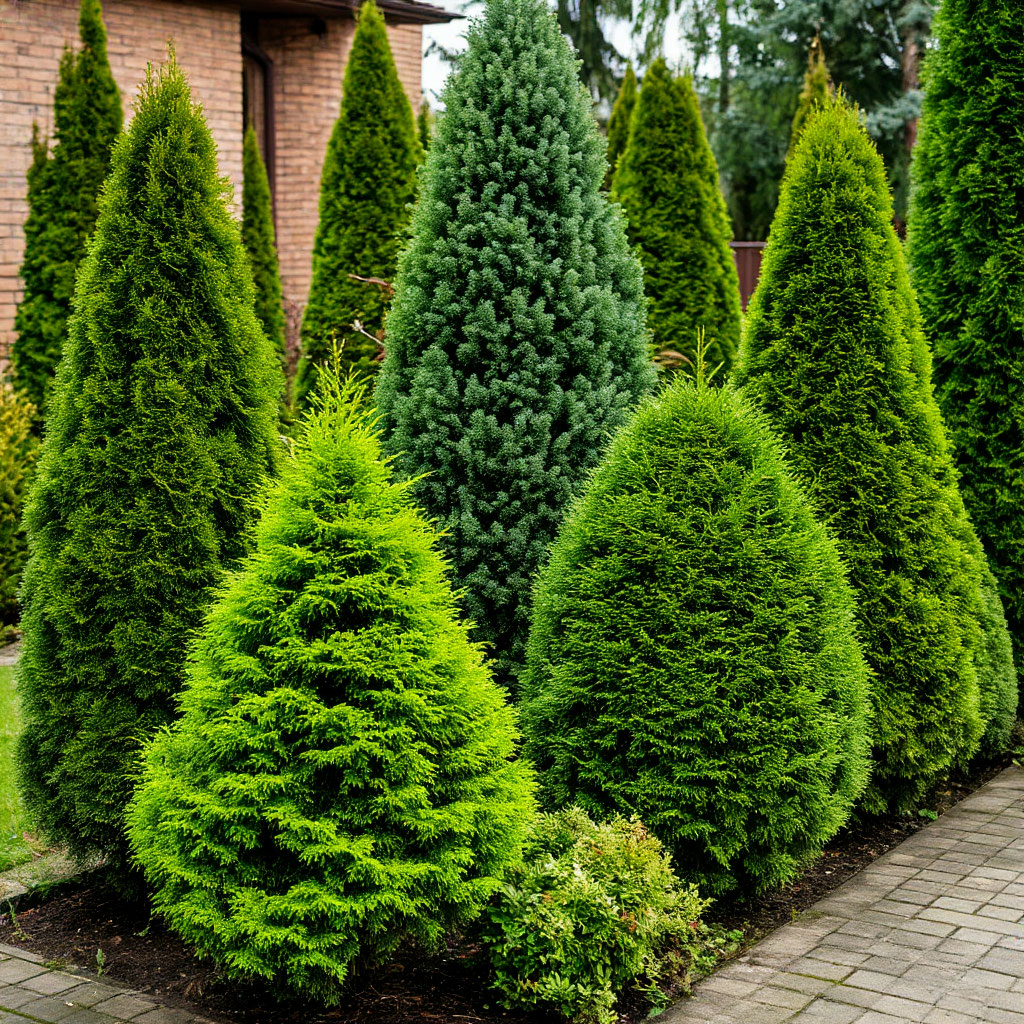
Why Evergreen Trees Are Still the Top Choice for Privacy
Evergreen trees are unmatched when it comes to reliable privacy. They create thick barriers that remain green all year long. Unlike deciduous trees that drop leaves in fall, evergreens maintain their coverage through snow, wind, and drought. For homeowners, that means dependable screening no matter the season.
What Sets Them Apart in Screening
Tree experts highlight their density and fast growth. A study by the University of Minnesota Extension found that evergreen hedges can reduce urban noise by 40–50%.
Dave Johnson, a professional arborist, explains: “Evergreens don’t just block views; they soften the landscape and bring life into the garden.”
For example, Canadian Hemlocks grow tall in shaded conditions, while holly provides glossy leaves and bright berries. Both combine beauty with resilience.
Practical Care Insights
Most evergreen privacy trees thrive in USDA zones 3 through 9, making them adaptable to a wide range of climates. Thuja and spruce varieties, in particular, show strong resistance to common pests and diseases, reducing the need for chemical treatments.
Testing soil pH before planting helps prevent nutrient imbalances that can weaken growth and slow development. Additionally, applying mulch around the base of the trees stabilizes root temperatures, protecting them from both extreme heat in summer and freezing conditions in winter.
Common Homeowner Questions
- Can evergreen privacy trees survive heavy snow? Yes, but pruning in spring prevents branches from snapping under weight.
- Do they need fertilizer every year? A balanced mix in early spring is enough. Overfeeding encourages weak growth.
- What if the yard is mostly shaded? Hemlock and yew adapt well to lower light.
These qualities explain why evergreen landscape privacy screens are still the go-to solution in 2025. They blend aesthetics with utility in ways fences or walls never can.
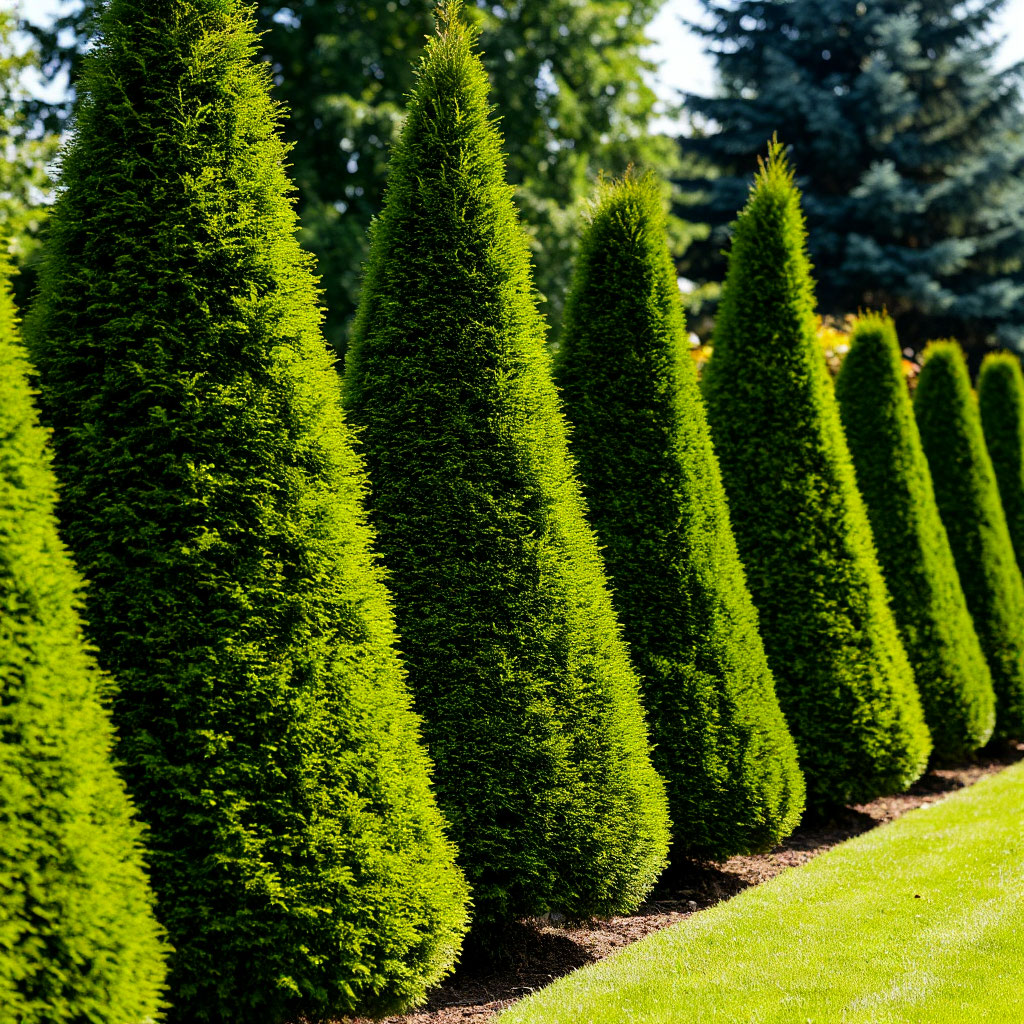
Top 5 Evergreen Varieties for Instant Privacy (2025 Picks)
The best evergreen hedges 2025 are those that grow quickly, adapt to different climates, and deliver dense coverage. Garden centers report strong demand for improved hybrids bred for disease resistance and drought tolerance. With the right pick, homeowners can enjoy noticeable privacy within just a few seasons. Selecting the best evergreen trees for privacy 2025 helps homeowners achieve instant screening and year-round appeal.
Standout Choices and Their Features
- Thuja Green Giant – Known for its speed, adding 3–5 feet of growth per year in zones 5–9. Tolerates drought once established.
- Leyland Cypress – A southern favorite that soars to 50 feet tall. Dense enough for windbreaks and great for larger properties.
- Emerald Green Arborvitae – Compact, topping at 15 feet, making it ideal for smaller suburban yards. Low maintenance and cold-hardy.
- Canadian Hemlock – Grows gracefully in partial shade and adapts to acidic soils. Excellent choice for woodland-style yards.
- American Holly – Adds ornamental red berries and glossy leaves. Resistant to most pests and supports bird habitats.
Landscape designer Emily Carter describes Leyland Cypress as “a wall of green that transforms a yard in just a few years.”
Choosing the Right Fit for Your Yard
When selecting from these top five:
- Consider soil type: sandy, loamy, or clay-heavy.
- Match to your sun exposure: full sun vs partial shade.
- Think about maintenance level: fast growers need more pruning.
- Always check hardiness zones before planting.
These best evergreen trees for privacy 2025 deliver quick results without sacrificing long-term health.

Year-Round Color and Structure: Evergreen Tree Benefits
Evergreen trees year-round interest lies in their ability to maintain visual appeal through every season. They keep color in winter when most landscapes look bare. At the same time, they add structure that complements flowers and shrubs in warmer months.
Why They Enhance Visual and Ecological Value
Botanists emphasize their role as steady anchors in garden design. Their needles and leaves range from deep emerald to silvery blue. A Proven Winners survey found that evergreens increase biodiversity by offering food and shelter for wildlife all year. White Pines, for example, soften landscapes with their airy needles, while junipers add rich texture in tight spaces.
Tips for Maximizing Appeal
To create a visually engaging evergreen privacy hedge, mix trees of different heights and shapes to prevent a monotonous appearance. Hemlocks work well in shaded corners, adding a soft texture to the landscape, while holly planted near patios provides bright color contrast during winter months.
Deep watering throughout the first year is essential for establishing strong, healthy roots. Light pruning each spring helps maintain shape and encourages fuller, denser growth, ensuring the hedge remains attractive and functional year-round.
Evergreen Benefit Comparison Table
| Variety | Color/Features | Structural Perks | Growth Rate (ft/year) | Hardiness Zones | Maintenance Needs |
| Thuja Green Giant | Bright green, fast | Dense pyramidal form | 3–5 | 5–9 | Moderate pruning |
| Leyland Cypress | Blue-green, tall | Column-like barrier | 3–4 | 6–10 | High pruning |
| Emerald Green Arborvitae | Deep emerald, compact | Narrow upright shape | 1–2 | 4–8 | Low maintenance |
| Canadian Hemlock | Dark green, soft needles | Graceful branches | 1–2 | 3–8 | Needs moist soil |
| American Holly | Glossy dark leaves, berries | Rounded shape | 1–2 | 5–9 | Light pruning |
These trees create beauty and stability that few other plants can match. With the right mix, any yard feels vibrant year-round.

Planting Tips for Dense Privacy Hedges
A thriving evergreen hedge begins with proper planning and care. The best evergreen trees for privacy 2025 need the right soil, spacing, and aftercare to reach full potential. Without preparation, gaps form and coverage takes longer.
Preparing the Perfect Site
Selecting the right location and preparing the soil properly is the foundation for a healthy evergreen privacy hedge. Soil quality, sunlight, and exposure to wind all influence how quickly trees establish and how dense the hedge becomes. By addressing these factors before planting, homeowners can avoid common issues like poor growth, weak roots, or leaning trees. Consider the following steps to create optimal conditions for your evergreens:
Test soil pH and adjust with lime or sulfur. Improve heavy clay with compost and sand for better drainage. Pick a location with at least 6 hours of sunlight for faster growth. For windy areas, choose sturdy species like spruce or fir.
Step-by-Step Planting Guide
Planting evergreen privacy trees correctly from the start ensures they grow into a dense, uniform hedge that lasts for decades. Each step matters, from preparing the soil to aligning the trees, because mistakes in the beginning are hard to fix later. With the right spacing, soil care, and watering routine, homeowners can establish a healthy screen that thrives with minimal problems in the future.
- Call a utility locate service, mark property lines, and sketch the hedge route with mature spacing for the chosen variety.
- Stage plants in bright shade and water containers thoroughly the day before planting to hydrate root balls.
- Snap a straight layout line with string and stakes; on slopes, use a level to set a consistent top line for the hedge.
- Dig each hole two to three times wider than the root ball and no deeper than the root flare to prevent settling.
- Roughen the sides and base of the hole with a shovel or fork so roots can break through compacted walls.
- Test drainage by filling the hole with water; if it still holds after 24 hours, amend soil or add a simple French drain.
- Lift the plant from its pot by the root ball, not the trunk; tease circling roots and make three to four vertical slices about ½ inch deep.
- Set the root flare at or slightly above the surrounding grade, facing the best side toward the primary view.
- Backfill with native soil blended with 20–30% finished compost, avoiding fertilizer in the planting hole.
- Water halfway through backfilling to settle soil, then finish filling and gently heel around the ball to remove air pockets.
- Build a shallow watering berm around the dripline and apply a 2–3 inch mulch layer, keeping mulch 3–4 inches off the trunk.
- Install drip irrigation with one to two emitters per plant, or a perforated ring, for slow, deep watering.
- Stake only in windy exposures using two stakes and soft, flexible ties; remove all staking after one growing season.
- Make a light top-and-side pinch to encourage branching, but leave the central leader intact on conifers intended for height.
- Follow variety spacing: 3–4 feet for arborvitae hedges, 5–6 feet for hemlock screens, and 6–8 feet for Leyland cypress on large lots.
- Water schedule: daily for the first 10–14 days if there is no rain, every 2–3 days through weeks 3–12, then weekly for the rest of the first year.
- Feed lightly in early spring of year two with a slow-release, balanced formula, and skip summer fertilization to avoid soft growth.
- Protect new plants with deer fencing or repellents where browsing is common, and wrap trunks in winter-prone zones to prevent sunscald.
- Re-check alignment from both ends of the run before roots knit in; adjust spacing or angle now for a clean, uniform line.
Ongoing Maintenance Checklist
Regular care keeps evergreen privacy trees healthy and dense. During summer, it is important to check for pests such as bagworms, which can weaken growth if left untreated. Light trimming once or twice a year helps maintain a clean shape and encourages fuller foliage.
Mulch should be changed annually as it protects the roots from extreme temperatures and retains soil moisture. To improve watering efficiency and provide deep moisture, one of the most effective long-term solutions is a drip irrigation system. There are creative ways to use mulch in an eco-friendly way in landscaping.
With these steps, a hedge thickens quickly and lasts for decades. A well-planned evergreen landscape privacy screen provides privacy without feeling forced.

Cost vs Performance: Best Value Privacy Evergreens
Finding balance between affordability and long-term performance is crucial. Some evergreens cost more upfront but save money later by reducing upkeep or energy bills. Prices in 2025 range widely, depending on tree size and source.
Comparing Common Options
When choosing the best evergreen hedges for your yard, it helps to understand the differences between common varieties. Each type varies in growth rate, mature height, shape, maintenance needs, and adaptability to soil or climate conditions.
By comparing these key factors, homeowners can select a hedge that provides reliable privacy, visual appeal, and long-term value. The following options highlight popular choices in 2025 for quick screening and year-round interest:
- Thuja Green Giant – Grows 3–5 feet a year in zones 5–9.
- Leyland Cypress – Tall, dense, and ideal for larger properties.
- Emerald Green Arborvitae – Compact, topping at 15 feet.
- Canadian Hemlock – Thrives in partial shade with soft foliage.
- American Holly – Decorative with red berries in winter.
Budget-Saving Strategies
Homeowners can reduce costs while establishing a high-quality evergreen privacy hedge by planning carefully. Buying smaller trees in bulk often provides significant long-term savings, as the plants grow into dense coverage over time. Installing a drip irrigation system helps conserve water while ensuring the roots receive deep, consistent moisture.
Choosing pest-resistant hybrid varieties minimizes the need for chemical treatments, reducing both effort and expense. Strategic placement of trees as windbreaks not only strengthens the hedge but can also lower heating bills during winter months. By combining these approaches, evergreen privacy trees become a smart investment that lasts for decades, far outlasting fences or other temporary solutions.
These practices ensure that evergreen privacy trees remain a smart investment. A fence may last 15 years, but evergreens thrive for decades with the right care.
FAQ
How do you protect evergreen privacy trees in harsh winters?
Wrap young trees in burlap and water deeply before the ground freezes. This protects roots and prevents dehydration.
Why pick arborvitae over cypress for small yards?
Arborvitae grows narrower and requires less pruning, making it perfect for compact spaces.
What’s better for wet soils among the best evergreen hedges 2025?
Bald Cypress adapts well to soggy ground, while most pines struggle in saturated conditions.
Do evergreen trees year-round interest help wildlife?
Yes. They provide shelter, nesting spots, and food like berries, supporting birds and small mammals all year.
How long before a hedge gives real privacy?
With fast growers like Thuja Green Giant, expect solid screening within 3–5 years. Slower types like holly take longer but offer richer seasonal interest.
You can look at which evergreen trees are best for privacy, how to care for them. By following these recommendations, you can create a beautiful and effective natural screen for your yard.
The best evergreen trees for privacy 2025 combine beauty, durability, and reliable coverage in ways fences can’t match. From the rapid growth of Thuja Green Giant to the seasonal flair of American Holly, these trees meet different yard needs while staying practical. They improve property value, reduce noise, and create year-round interest for both people and wildlife.
Homeowners planning a new hedge should start with soil testing, smart spacing, and consistent aftercare. Local nurseries remain the best place to find varieties tailored to each region. With thoughtful planting, an evergreen landscape privacy screen transforms a backyard into a private retreat.
Now is the right time to plant. These trees grow quickly, adapt well, and deliver lasting seclusion. Choose your variety, prepare the ground, and enjoy the benefits for decades ahead. Planting the best evergreen trees for privacy 2025 transforms any backyard into a private, attractive retreat. For clean, comparable quotes, print the checklist and send it with your request today.
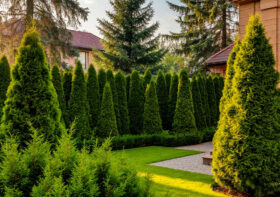
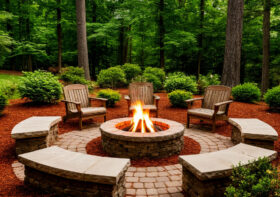

Leave a Reply